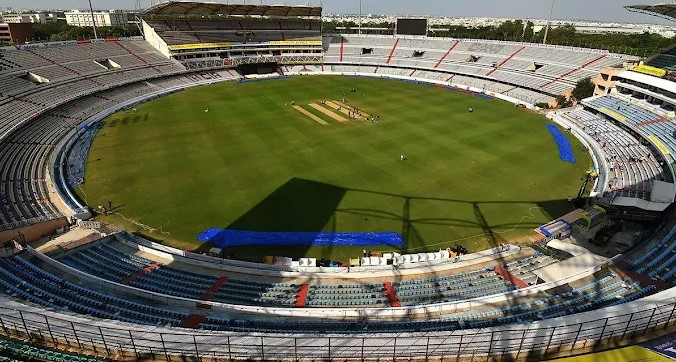The Rajiv Gandhi International Cricket Stadium, located in Hyderabad, India, is one of the premier cricket venues in the country. Known for its modern infrastructure, passionate crowd, and vibrant cricketing atmosphere, this stadium has hosted a variety of high-profile matches — from Indian Premier League (IPL) games to international fixtures. One often overlooked but critical element influencing match outcomes here is the boundary dimensions.
Table of Contents
In this article, we explore the boundary lengths at the stadium, how they affect the game, and comparisons with other major stadiums.
Stadium Overview
- Location: Uppal, Hyderabad, Telangana
- Established: 2005
- Seating Capacity: 55,000
- Home Teams: Sunrisers Hyderabad (IPL), Hyderabad (Ranji Trophy)
The stadium has been strategically designed to maximize crowd experience and television viewership. While the pitch conditions vary from season to season, the ground’s dimensions tend to play a consistent role in shaping game dynamics.
Boundary Lengths at Rajiv Gandhi Stadium
Boundary dimensions at cricket stadiums are not fixed; they can vary slightly depending on how the pitch is positioned and whether drop-in pitches or temporary setups are used. However, average boundary lengths at the Rajiv Gandhi Stadium remain within a specific range.
Average Boundary Lengths
| Boundary Side | Approximate Length (in meters) |
|---|---|
| Straight Boundaries | 70 to 75 |
| Square Boundaries | 63 to 68 |
| Long-On / Long-Off | 68 to 72 |
| Third Man / Fine Leg | 60 to 65 |
| Behind the Wicket | 58 to 62 |
These figures place Rajiv Gandhi Stadium in the mid-to-large size range compared to other stadiums in India.
Impact of Boundary Size on Match Strategy
1. Batsman-Friendly Dimensions
The relatively shorter square boundaries (averaging around 65 meters) make the ground conducive to aggressive stroke play. Batsmen often target these areas for sixes, particularly during powerplay overs and death overs in T20 games.
2. Bowlers’ Tactical Adaptation
Bowlers, especially spinners and medium-pacers, tend to adapt their lengths and angles. Delivering wide outside off or targeting the longer parts of the field (like straight boundaries) is a common tactic.
3. Field Placement
Captains often station fielders on the shorter square boundaries to guard against cut shots and pull shots. At the same time, long-on and long-off remain crucial positions due to the tendency of batters to clear the infield.
Comparative Analysis with Other Indian Grounds
Boundary Comparison with Other Stadiums
| Stadium | Straight (m) | Square (m) | Total Area Perimeter (approx.) |
|---|---|---|---|
| Rajiv Gandhi Intl., Hyderabad | 70-75 | 63-68 | 260-270 m |
| Wankhede, Mumbai | 66-70 | 60-65 | 250-260 m |
| Eden Gardens, Kolkata | 69-74 | 65-70 | 265-275 m |
| M. Chinnaswamy, Bengaluru | 68-72 | 58-64 | 250-265 m |
| Narendra Modi, Ahmedabad | 75-78 | 68-72 | 280-290 m |
As seen above, the Rajiv Gandhi Stadium sits between the smaller Wankhede and the much larger Narendra Modi Stadium, making it fairly balanced in terms of hitting conditions.
Notable Matches and Boundary Impact
Several matches at the Rajiv Gandhi International Stadium have demonstrated how its dimensions influence gameplay:
- IPL 2019 Final (MI vs CSK): A low-scoring thriller where bowlers used the long boundaries to trap batsmen into mistimed shots.
- India vs West Indies, 2018: Virat Kohli’s dominant century used square boundaries effectively, highlighting how short sides can be exploited by top-class batsmen.
- SRH Home Games (IPL): Sunrisers Hyderabad frequently utilize spin-heavy strategies, aided by longer straight boundaries to protect runs.
Fan Perspective
From a spectator’s point of view, the balanced ground size allows for a mix of high-scoring and closely contested games. Sitting near the boundary ropes provides an exhilarating view of both six-hitting and fielding heroics.
Future Changes or Innovations?
Although the current layout suits most formats well, innovations like movable boundaries or pitch re-centering might lead to slight dimensional changes. However, the core structure ensures a fair contest between bat and ball.
The Rajiv Gandhi International Cricket Stadium in Hyderabad is more than just a venue; it’s a tactical battleground where boundary dimensions significantly influence how the game is played. With average straight boundaries around 70–75 meters and square boundaries at 63–68 meters, it provides a balanced contest, rewarding both aggressive batting and smart bowling.
Whether you’re a cricket strategist, an aspiring player, or a die-hard fan, understanding ground dimensions can give you deeper insights into match outcomes — and Hyderabad offers one of the more tactically nuanced surfaces in Indian cricket today.


